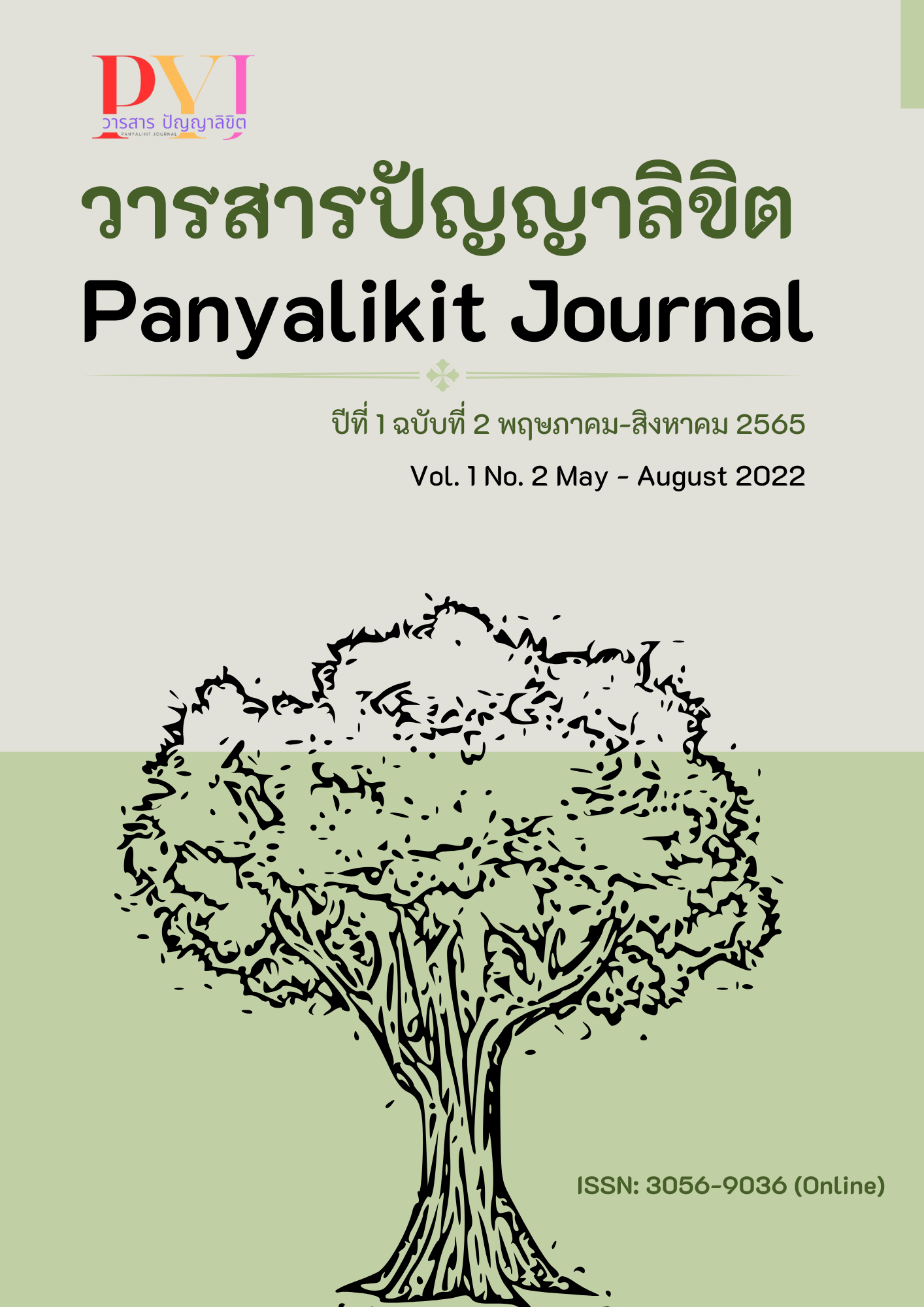Anapanasati: A Guide to Treating People With Depression
Main Article Content
Abstract
This article is intended to study Arabic. Anapanasati is a therapy approach for people with depression. It is found that depression is another disease with a growing number of patients, but not many of them know of depression. Some people are self-conscious or self-conscious because they think that they are not properly treated and are in good time. Depression can have a significant impact on the day-to-day life of both physical and mental life. Whether it is tedious, depressed, or suicidal sleep, there is a problem with eating, as well as suicidal sleep. One of the leading causes of depression is that the mental state of each person is not the same. This is due to the environment and horrific events in life that affect the process of thinking and perspective, such as pessimism, despair, or lack of self-esteem. Etc. In Buddhism, Anapanasati a conscious focus is the study of consciousness. It is based on the principles of determining the breath in and out of the mind to concentrate, focus, and focus. To develop a better life in a daily lifestyle, take a moderate approach to therapy, such as the Anapanasati approach, and provide many benefits to people with severe depression. It is the best way to improve their minds. Having good spirits results in good exercise to continue living with others in society.
Article Details

This work is licensed under a Creative Commons Attribution-NonCommercial 4.0 International License.
References
จำลอง ดิษยวณิช และพริ้มเพรา ดิษยวณิช. (2545). ความเครียด ความวิตกกังวลและสุขภาพ. เชียงใหม่: เชียงใหม่โรงพิมพ์แสงศิลป์.
ณรงค์ สุภัทรพันธุ์, (2543). โรคอารมณ์ซึมเศร้า. กรุงเทพฯ: หน้าต่างสู่โลกกว้าง.
บริษัท รีดเดอร์ส ไดเจสท์ (ประเทศไทย) จำกัด, (2544). บำบัดโรคด้วยการแพทย์ทางเลือก. กรุงเทพฯ: เพชรกะรัต.
ประเสริฐ ผลิตผลการพิมพ์. (2561). โรคซึมเศร้า. กรุงเทพฯ: อมรินทร์เฮลท์.
พระธรรมกิตติวงศ์ (ทองดี สุรเตโช). (2551). พจนานุกรมเพื่อการศึกษาพุทธศาสน์ “คำวัด”. พิมพ์ครั้งที่ 3. กรุงเทพฯ: สถาบันบันลือธรรม.
พระธรรมธีรราชมหามุนี (โชดก). (2546). หลักปฏิบัติสมถะและวิปัสสนากรรมฐาน. พิมพ์ครั้งที่ 6. กรุงเทพฯ: สหธรรมิก.
พระธรรมปิฎก (ป.อ.ปยุตฺโต). (2546). พุทธธรรม ฉบับปรับปรุงและขยายความ. พิมพ์ครั้งที่ 11. กรุงเทพฯ: มหาจุฬาลงกรณราชวิทยาลัย.
พระธรรมปิฎก (ประยุทธ์ ปยุตฺโต). (2540). สมาธิ: ฐานสู่สุขภาพจิตและปัญญาหยั่งรู้. พิมพ์ครั้งที่ 5. กรุงเทพฯ: ศยาม.
พระปราโมทย์ ปาโมชฺโช. (2554). แนวทางการปฏิบัติธรรมในพระพุทธศาสนา. กรุงเทพฯ: อักษรสัมพันธ์.
พระพรหมคุณาภรณ์ (ป.อ.ปยุตฺโต). (2559). การแพทย์ยุคใหม่ในพุทธทัศน์. พิมพ์ครั้งที่ 17. กรุงเทพฯ: ผลิธัมม์.
พระภาวนาพิศาลเมธี (พรหมจันทร์). (2562). การยกอารมณ์ฌานขึ้นสู่วิปัสสนา ตามแนวอานาปานสติภาวนา. กรุงเทพฯ: ประยูรสาส์นไทย.
พุทธทาสภิกขุ. (2536). วิธีฝึกสมาธิ วิปัสสนา. กรุงเทพฯ: อรุณวิทยา.
พุทธทาสภิกขุ. (2553). คู่มือศึกษาและปฏิบัติธรรมแบบอานาปานสติ ฉบับสมบูรณ์. กรุงเทพฯ: เยลโล่.
พุทธทาสภิกขุ. (2555). สุขมหัศจรรย์จากลมหายใจ. กรุงเทพฯ: เลี่ยงเชียง เพียรเพื่อพุทธศาสน์.
พุทธทาสภิกขุ. (2559). คู่มือปฏิบัติอานาปานสติ. กรุงเทพฯ: ธรรมสภา.
มหาจุฬาลงกรณราชวิทยาลัย. (2539). พระไตรปิฎกฉบับภาษาไทย ฉบับมหาจุฬาลงกรณราชวิทยาลัย. กรุงเทพฯ: มหาจุฬาลงกรณราชวิทยาลัย.
มหาจุฬาลงกรณราชวิทยาลัย. (2539). อรรถกถาภาษาไทย ฉบับมหาจุฬาลงกรณราชวิทยาลัย. กรุงเทพฯ: มหาจุฬาลงกรณราชวิทยาลัย.
ราชบัณฑิตยสถาน. (2542). พจนานุกรมฉบับราชบัณฑิตยสถาน. กรุงเทพฯ: นานมีบุ๊คส์พับลิเคชั่นส์.
ลักขณา สริวัฒณ์. (2544). จิตวิทยาในชีวิตประจำวัน. กรุงเทพฯ: โอเดียนสโตร์.
วินิตา รัตตบูรณินท์.(2542). อยู่ร้อยปีไม่มีแก่: ใช้ชีวิตอย่างไรจะไกลหมอ. พิมพ์ครั้งที่ 5, กรุงเทพฯ: ธรรมสภา.
Bangkok Hospitol. (2562). ประเภทโรคซึมเศร้า (DEPRESSION). สืบค้นเมื่อ 3 พฤษภาคม 2564, จากhttps://www.bangkokhospital.com/th/disease-treatment/depression-type


